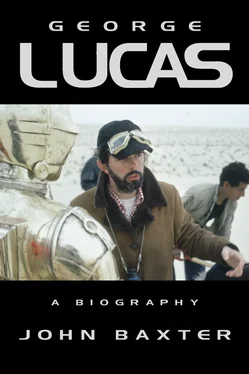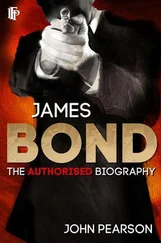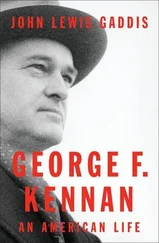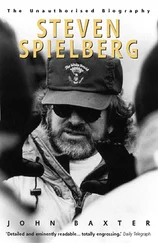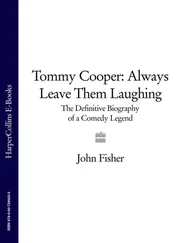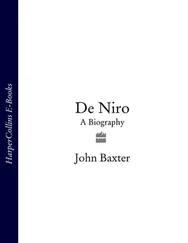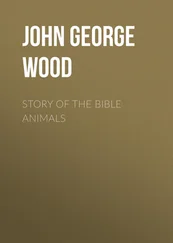With his car wrecked and no chance of financing another, Lucas’s racing days were at an end, unless he took a job as a mechanic servicing someone else’s ride. On the plus side, he had, against the odds, graduated from high school; though this had its negative aspects too, since he now became eligible to be drafted. At the end of American Graffiti , Terry the Toad, the character with whom Lucas is most identified, goes to Vietnam, where he is listed as missing in action – a fate explained in ironic detail in More American Graffiti .
Vietnam posed a potent threat to teenagers like Lucas in 1962. Many, including his future partner Gary Kurtz, served their stint. Some were judged too unhealthy for the army, as Lucas would be, though he didn’t yet know it. Others found a way around it. Steven Spielberg would have been happy to hang out in San Jose, California after his high-school graduation (with grades as poor as Lucas’s), seeing movies and making a few of his own on 8mm, but the arrival of his Selective Service Notice in early 1964 – delivered by his father while he waited in line to see Stanley Kubrick’s Dr Strangelove or How I Learned to Stop Worrying and Love the Bomb – concentrated his mind wonderfully, and he enrolled at California State College at Long Beach, thus gaining a student exemption.
As he convalesced, Lucas decided to continue in school, and enrolled in junior college. These halfway houses between high school and college offered two-year courses, usually vocational. In the fall of 1962, Lucas enrolled in Modesto Junior College, assembling an arts major that even further exasperated his father: astronomy, sociology, speech, and art history – none of them any use in selling office supplies.
Except for speech, which Lucas hoped would improve his limited communication skills and eradicate his warbling croak of a voice (it didn’t; he admits he was ‘terrible in Speech class’), the other courses were those traditionally chosen by adolescents who, having rejected religion, are looking for a new belief system based in rationalism. Reason and science become the new gods. The new believer finds himself worshipping the Divine Order, the Power of the Mind, the Inevitability of Historical Change.
Already, an ambitious science fiction writer named Lafayette Ron Hubbard had cashed in on this thirst for certainties by inventing his own quasi-scientific religion, Scientology, which, with notable shrewdness, he’d launched via an article in the popular magazine Astounding Science Fiction . The same magazine gave generous publicity to the experiences of Dr Joseph Rhine of Duke University in hunting the elusive signs of what he christened ‘psi powers’: telepathy and telekinesis.
Lucas later read the basic works of sociology and anthropology which traced modern religion and morality back to their roots in tribal rituals and earth magic. But though he has been credited, retrospectively, with a near-lifelong interest in cultural studies and science fiction which blossomed in the Star Wars films, nobody can remember him being interested in anything but television and cars until long after he left Modesto.
In 1964 Lucas graduated from Modesto Junior College with an Associate in Arts degree, and an A in astronomy and Bs in speech, sociology, and art history. His grade average hovered around C, but that was enough to get into all but the most demanding colleges. John Plummer urged him to try USC with him. But Lucas decided he didn’t want to move that far from home. Instead he enrolled at San Francisco State, which had the added advantage of being free.
He still had no clear idea of what career he might follow. At junior college he’d drifted back to photography, this time with an 8mm movie camera bought by his father. Though he no longer had ambitions to drive competitively, he also spent time around the race circuits, hanging out with Allen Grant and other old friends, but filming rather than tinkering with their cars. ‘I wasn’t the hot guy any more,’ he recalled. ‘I was sort of over the hill, though I still knew all the guys.’
Lucas discovered the pleasures of watching, ideally through the lens of a camera. People didn’t ask awkward questions when you filmed them; they just let you be. And, seen through the camera, they themselves came into sharper focus. You could observe, comment, categorize, without saying a word.
What Lucas found more interesting than human beings, however, were objects. On occasional visits to Berkeley, he saw films of the new American ‘underground’ – Stan Brakhage’s jittering 8mm diaries, Jonas Mekas’s Guns of the Trees (1961), the abstractions of Harry Smith, John and James Whitney, Robert Breer, and in particular Jordan Belson, who projected his wobbling psychedelic creations on the walls of the San Francisco Planetarium.
The hot documentary from 1960 was Jazz on a Summer’s Day , about the Newport Jazz Festival, the first and only film by fashion photographer Bert Stern. Stern didn’t bother much with interviews. He preferred to stand back and film faces, or the reflections of yacht hulls on the surface of the water, which he cut to music by Mose Allison. There was no commentary, no point of view except that of the camera, no judgments, no argument, no plot. Lucas must have said to himself with some satisfaction, ‘I can do that.’ A year later, his student film Herbie would be made up entirely of reflections on the hubcaps and polished surface of a car, set to jazz by Herbie Hancock. Lucas’s first film, made as a child, had been of plates, not people, and he didn’t much change as an adult. His early student films would all be about cars. He shot them from a distance and up close, noticing the reflections on a polished fender or a windscreen; or clipped photographs from magazines and cut between them to create a narrative that bypassed performance. The idea of directing actors was, and would remain, distasteful.
No two people agree on how Lucas made the first step in the journey from Sunday cameraman to the most successful film-maker in history, but there’s little doubt that cinematographer and documentary filmmaker Haskell Wexler came into it.
The early sixties saw the arrival of new lightweight 16mm cameras and the documentary movement they engendered, cinéma vérité . The image of the cameraman with a 16mm Arriflex on his shoulder and a Nagra tape recorder close to hand – though not in hand; most professional tape machines still weighed twenty pounds – became a potent one, and even more so when Eclair launched its NPR, a sleek, updated version of the hand-held 16mm camera. With such equipment, a film-maker was independent, able to shoot where he liked, and with as little light as fast new film stocks would accept. Albert and David Maysles began turning out films in what they called ‘Direct Cinema.’ They were soon joined by Richard Leacock, D.A. Pennebaker and Robert Drew, who, as Drew Leacock Pennebaker, set most of the benchmarks with films like Primary, The Chair , and, as far as Lucas was concerned, the 1960 Eddie , about racing driver Eddie Sachs.
Haskell Wexler was thirty-six, and widely respected as a cameraman with a penchant for realism and a strong leftist political commitment. In 1958, Irvin Kershner had persuaded producer Roger Corman to finance Stakeout on Dope Street , a low-budget thriller about three boys who find a case full of drugs, and are pursued by the gang who owns it. Kershner co-wrote and directed. Wexler shot part of the film, adapting hand-held, low-light documentary technique to drama. He also lit Kershner’s The Hoodlum Priest (1961), and A Face in the Rain (1963). In between, he worked on low-budget experimental films like The Savage Eye (1960), and on documentaries. It was one of these that brought him to Modesto.
Читать дальше
